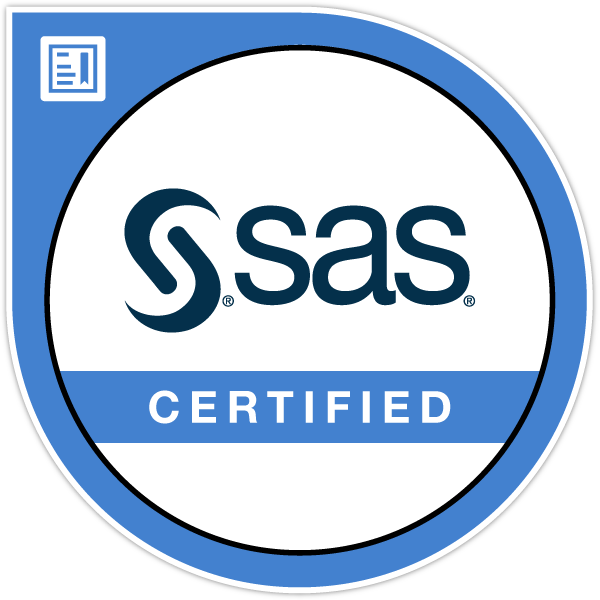Statistics 1: Introduction to ANOVA, Regression, and Logistic Regression
5h 37m + Hands-On Practice
Available in:
Statistics 1: Introduction to ANOVA, Regression, and Logistic Regression
STAT1 : ST142
This introductory course is for SAS software users who perform statistical analyses using SAS/STAT software. The focus is on t tests, ANOVA, and linear regression, and includes a brief introduction to logistic regression. This course (or equivalent knowledge) is a prerequisite to many of the courses in the statistical analysis curriculum.
A more advanced treatment of ANOVA and regression occurs in the Statistics 2: ANOVA and Regression course. A more advanced treatment of logistic regression occurs in the Categorical Data Analysis Using Logistic Regression course and the Predictive Modeling Using Logistic Regression course.
A more advanced treatment of ANOVA and regression occurs in the Statistics 2: ANOVA and Regression course. A more advanced treatment of logistic regression occurs in the Categorical Data Analysis Using Logistic Regression course and the Predictive Modeling Using Logistic Regression course.
Learn How To
- Generate descriptive statistics and explore data with graphs.
- Perform analysis of variance and apply multiple comparison techniques.
- Perform linear regression and assess the assumptions.
- Use regression model selection techniques to aid in the choice of predictor variables in multiple regression.
- Use diagnostic statistics to assess statistical assumptions and identify potential outliers in multiple regression.
- Use chi-square statistics to detect associations among categorical variables.
- Fit a multiple logistic regression model.
- Score new data using developed models.
Who Should Attend
Statisticians, researchers, and business analysts who use SAS programming to generate analyses using either continuous or categorical response (dependent) variables
Prerequisites
Before attending this course, you should:
- Have completed the equivalent of an undergraduate course in statistics covering p-values, hypothesis testing, analysis of variance, and regression.
- Be able to execute SAS programs and create SAS data sets. You can gain this experience by completing the SAS® Programming 1: Essentials course.
SAS Products Covered
SAS/STAT
Course Outline
Course Overview and Review of Concepts
- Descriptive statistics.
- Inferential statistics.
- Examining data distributions.
- Obtaining and interpreting sample statistics using the UNIVARIATE procedure.
- Examining data distributions graphically in the UNIVARIATE and FREQ procedures.
- Constructing confidence intervals.
- Performing simple tests of hypothesis.
- Performing tests of differences between two group means using PROC TTEST.
- Performing one-way ANOVA with the GLM procedure.
- Performing post-hoc multiple comparisons tests in PROC GLM.
- Producing correlations with the CORR procedure.
- Fitting a simple linear regression model with the REG procedure.
- Performing two-way ANOVA with and without interactions.
- Understanding the concepts of multiple regression.
- Automated model selection techniques in PROC GLMSELECT to choose from among several candidate models.
- Interpreting and comparison of selected models.
- Examining residuals.
- Investigating influential observations.
- Assessing collinearity.
- Understanding the concepts of predictive modeling.
- Understanding the importance of data partitioning.
- Understanding the concepts of scoring.
- Obtaining predictions (scoring) for new data using PROC GLMSELECT and PROC PLM.
- Producing frequency tables with the FREQ procedure.
- Examining tests for general and linear association using the FREQ procedure.
- Understanding exact tests.
- Understanding the concepts of logistic regression.
- Fitting univariate and multivariate logistic regression models using the LOGISTIC procedure.
- Using automated model selection techniques in PROC LOGISTIC including interaction terms.
- Obtaining predictions (scoring) for new data using PROC PLM.
Live Class Schedule
Duration: 21 hours
Step into our live classes and experience a dynamic learning environment where you can ask questions, share ideas, and connect with your instructor and classmates. With on-demand lab hours, you can explore the material at your own pace. Our globally acclaimed instructors will motivate you to think bigger, so you can take what you've learned and achieve your biggest goals.
This course isn't publicly scheduled, but private training and mentoring may be available. Contact us to explore options.
Private Training
Get training tailored specifically for your team, led by expert SAS instructors. Choose from virtual sessions, or training at your location (or ours). Perfect for teams seeking a customized curriculum and plenty of interaction with a SAS specialist. We'll schedule it at a time that works for you.
Mentoring Services
Take your training to the next level with personalized mentoring. While private training offers structured coursework, mentoring provides hands-on, real-time support from a subject matter expert. As you work with your own data, you'll receive expert guidance to help you uncover insights, unlock the full potential of your data, and make faster progress. Perfect for those looking to apply what they’ve learned and see quicker results.

This course helps prepare you to earn the following SAS Credentials:
SAS Certification Manager
SAS partners with Pearson VUE to provide you with the best possible certification experience.
Certification Resources



